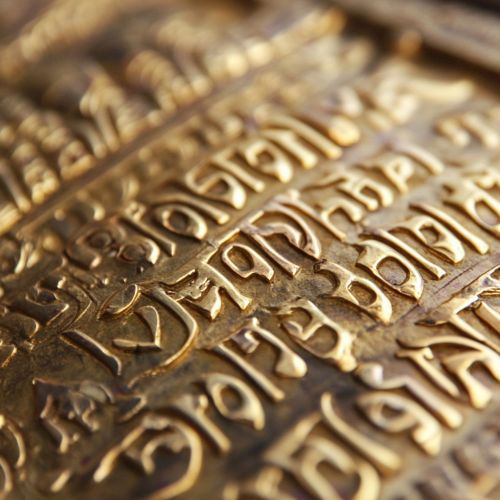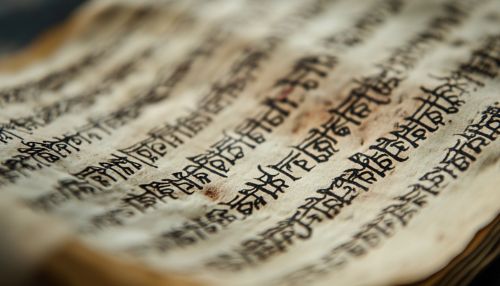Nepali: Difference between revisions
(Created page with "== Introduction == Nepali, also known as Nepalese, is an Indo-Aryan language spoken primarily in Nepal and by Nepali communities in India, Bhutan, and Myanmar. It serves as the official language of Nepal and one of the 22 scheduled languages of India. Nepali is written in the Devanagari script and has a rich literary tradition, deeply influenced by Sanskrit and other regional languages. == Historical Background == The origins of the Nepali language can be traced back to...") |
No edit summary |
||
| Line 18: | Line 18: | ||
Nepali is written in the Devanagari script, which is an abugida, meaning that each character represents a consonant-vowel combination. The script consists of 47 primary characters, including 33 consonants and 14 vowels. Diacritical marks are used to modify the inherent vowel sounds of the consonants. The Devanagari script is also used for other languages such as Hindi and Marathi, making it one of the most widely used scripts in the Indian subcontinent. | Nepali is written in the Devanagari script, which is an abugida, meaning that each character represents a consonant-vowel combination. The script consists of 47 primary characters, including 33 consonants and 14 vowels. Diacritical marks are used to modify the inherent vowel sounds of the consonants. The Devanagari script is also used for other languages such as Hindi and Marathi, making it one of the most widely used scripts in the Indian subcontinent. | ||
[[Image:Detail-98043.jpg|thumb|center|Close-up of Nepali text written in Devanagari script.|class=only_on_mobile]] | |||
[[Image:Detail-98044.jpg|thumb|center|Close-up of Nepali text written in Devanagari script.|class=only_on_desktop]] | |||
== Literature == | == Literature == | ||
Latest revision as of 18:09, 20 September 2024
Introduction
Nepali, also known as Nepalese, is an Indo-Aryan language spoken primarily in Nepal and by Nepali communities in India, Bhutan, and Myanmar. It serves as the official language of Nepal and one of the 22 scheduled languages of India. Nepali is written in the Devanagari script and has a rich literary tradition, deeply influenced by Sanskrit and other regional languages.
Historical Background
The origins of the Nepali language can be traced back to the ancient Khas people of the Karnali region in western Nepal. The language evolved from the Sanskrit-based Prakrit languages and was influenced by various regional dialects. The earliest known inscriptions in Nepali date back to the 13th century, but it was not until the 18th century that the language began to gain prominence under the Gorkha Kingdom, which later unified Nepal.
Linguistic Features
Phonology
Nepali has a complex phonological system, characterized by a variety of consonants and vowels. The language includes aspirated and unaspirated consonants, retroflex sounds, and a series of nasalized vowels. The phonemic inventory of Nepali is extensive, with 36 consonants and 12 vowels.
Morphology
Nepali is an inflectional language, meaning that it uses a variety of affixes to indicate grammatical relationships. Nouns are inflected for number, gender, and case, while verbs are conjugated to reflect tense, aspect, mood, and person. Nepali also employs postpositions, which function similarly to prepositions in English.
Syntax
The typical word order in Nepali is Subject-Object-Verb (SOV). However, due to its relatively free word order, Nepali allows for flexibility in sentence structure, which can be influenced by factors such as emphasis and context. The language also makes extensive use of honorifics and politeness levels, which are reflected in verb conjugations and pronoun usage.
Writing System
Nepali is written in the Devanagari script, which is an abugida, meaning that each character represents a consonant-vowel combination. The script consists of 47 primary characters, including 33 consonants and 14 vowels. Diacritical marks are used to modify the inherent vowel sounds of the consonants. The Devanagari script is also used for other languages such as Hindi and Marathi, making it one of the most widely used scripts in the Indian subcontinent.


Literature
Nepali literature has a rich history, with its roots in oral traditions and religious texts. The earliest known literary work in Nepali is the "Bhanubhakta Ramayana," a translation of the Hindu epic Ramayana by the poet Bhanubhakta Acharya in the 19th century. This work played a significant role in popularizing the Nepali language and establishing a literary tradition.
Classical Literature
Classical Nepali literature is heavily influenced by Sanskrit, with many works focusing on religious and philosophical themes. Notable classical poets include Lekhnath Paudyal and Motiram Bhatta, who contributed significantly to the development of Nepali poetry and prose.
Modern Literature
The modern era of Nepali literature began in the early 20th century, marked by the rise of new literary forms and themes. Writers such as Laxmi Prasad Devkota, Parijat, and Bhupi Sherchan introduced contemporary issues and experimented with different genres, including novels, short stories, and essays. The modern literary movement has continued to evolve, with contemporary authors exploring diverse topics and styles.
Dialects and Regional Variations
Nepali has several dialects, which can be broadly categorized into eastern, central, and western varieties. These dialects exhibit variations in phonology, vocabulary, and syntax. The standard form of Nepali, based on the dialect spoken in the Kathmandu Valley, serves as the basis for official communication and education.
Eastern Dialects
Eastern dialects of Nepali are spoken in regions such as Ilam, Jhapa, and Morang. These dialects are characterized by their unique intonation patterns and lexical differences. For example, the eastern dialects often incorporate loanwords from neighboring languages such as Maithili and Bengali.
Central Dialects
Central dialects are spoken in the Kathmandu Valley and surrounding areas. This region is considered the linguistic heartland of Nepali, and the dialect spoken here forms the basis of the standard language. Central dialects are known for their relatively conservative phonological features and extensive use of honorifics.
Western Dialects
Western dialects are spoken in regions such as Pokhara, Palpa, and Doti. These dialects exhibit significant phonological and lexical variations compared to the standard language. For instance, western dialects often feature retroflex consonants and unique vowel sounds not found in other dialects.
Sociolinguistic Aspects
Nepali serves as a lingua franca in Nepal, facilitating communication among speakers of different languages and ethnic groups. The language plays a crucial role in national identity and cultural cohesion. In addition to its official status in Nepal, Nepali is also recognized as a minority language in India, where it is spoken by the Nepali diaspora in states such as Sikkim and West Bengal.
Language Policy and Education
The government of Nepal has implemented various language policies to promote the use of Nepali in education and administration. Nepali is the medium of instruction in most schools and universities, and it is also used in government documents and legal proceedings. Efforts are being made to preserve and promote indigenous languages alongside Nepali, recognizing the country's linguistic diversity.
Media and Communication
Nepali is widely used in print and electronic media, including newspapers, television, and radio. Prominent Nepali-language newspapers include "Gorkhapatra" and "Kantipur," while popular television channels such as "Nepal Television" and "Kantipur TV" broadcast in Nepali. The language also has a significant presence on the internet, with numerous websites, blogs, and social media platforms catering to Nepali speakers.
Cultural Significance
Nepali is deeply intertwined with the cultural and religious practices of the Nepali people. The language is used in various cultural expressions, including music, dance, and festivals. Traditional Nepali music, such as folk songs and classical ragas, often features lyrics in Nepali, reflecting the language's role in preserving cultural heritage.
Festivals and Rituals
Nepali is the primary language used in many religious and cultural festivals, such as Dashain, Tihar, and Teej. These festivals involve rituals, prayers, and performances conducted in Nepali, highlighting the language's significance in spiritual and communal life.
Folklore and Oral Traditions
Nepali folklore and oral traditions encompass a wide range of stories, myths, and legends passed down through generations. These narratives often feature themes of heroism, morality, and the supernatural, and they play a vital role in preserving the cultural identity of the Nepali people.
Challenges and Future Prospects
Despite its widespread use, the Nepali language faces several challenges, including the influence of globalization and the dominance of English in education and business. Efforts are being made to address these challenges through language preservation initiatives and the promotion of Nepali in various domains.
Language Preservation
Organizations and institutions in Nepal are working to document and preserve the Nepali language, as well as other indigenous languages. These efforts include the creation of dictionaries, grammars, and language courses, as well as the promotion of Nepali literature and cultural activities.
Technological Advancements
The advent of digital technology has opened new avenues for the promotion and preservation of the Nepali language. Online platforms, mobile applications, and digital libraries provide access to Nepali-language resources, enabling speakers to engage with the language in innovative ways.
